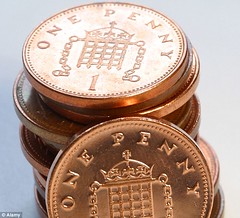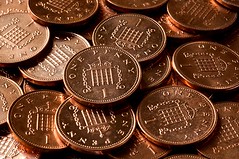
PREV ARTICLE
NEXT ARTICLE
FULL ISSUE
PREV FULL ISSUE
ARTICLE: SHOULD BRITAIN ELIMINATE THE PENNY?
Should Britain eliminate the penny? Coming on the heels of Canada's decision to stop manufacturing their smallest
coin is this article discussing that possibility. It includes a capsule history of the coin; here are some
excerpts.
-Editor
No matter that there are more than 11 billion in circulation, a growing number of Britons think we can do without one of the oldest coins in our history. Canada has already ditched its cent (known as a penny) – following similar moves in Australia and New Zealand to abolish their low–denomination coins. With the U.S. and Russia toying with the idea of doing away with fiddly cents and kopeks (one–hundredth of a rouble and the equivalent of our penny), should we follow suit? On the other side of the argument are the coin conservationists led by Katie Eagleton, curator of modern money at the British Museum, and Phil Mussell, director of Coin News, arbiter of all things numismatic. Mr Mussell says that every penny costs just 0.3p to produce and is therefore still economically viable. And if you don't want it cluttering up your life, what's stopping you from giving it to charities, who would be glad to have it jangling in their tins. However, in the anti-penny lobby is David Buik, of the City stockbroker BGC Partners, who says: 'After losing several hundred per cent of its value in the past two to three decades, the penny seems like a complete waste of time and space.' The little coin dates back to the 8th century and the days of King Offa, the monarch who famously built a fortification separating England from Wales. He introduced Britain's first coinage since Roman occupation, basing it on a continental prototype.
It was not until the 19th century that copper was used regularly to make pennies. They were so thick and heavy that they were known as cartwheels. By Queen's Victoria's time, the days of copper were over and pennies were made of bronze, with the Queen's head on one side and Britannia bearing a trident on the other. This coin, which was slightly larger than today's 2p piece, remained in currency until 1970.
To read the complete article, see:
GLENYS ROBERTS: Should we abolish the penny? Campaign to consign the coin to history is gaining currency
(www.thisismoney.co.uk/money/article-2133789/GLENYS-ROBERTS The Numismatic Bibliomania Society is a non-profit organization promoting numismatic literature. See our web site at coinbooks.org. To submit items for publication in The E-Sylum, write to the Editor at this address: whomren@gmail.com To subscribe go to: https://my.binhost.com/lists/listinfo/esylum All Rights Reserved. NBS Home Page Contact the NBS webmaster 
|

